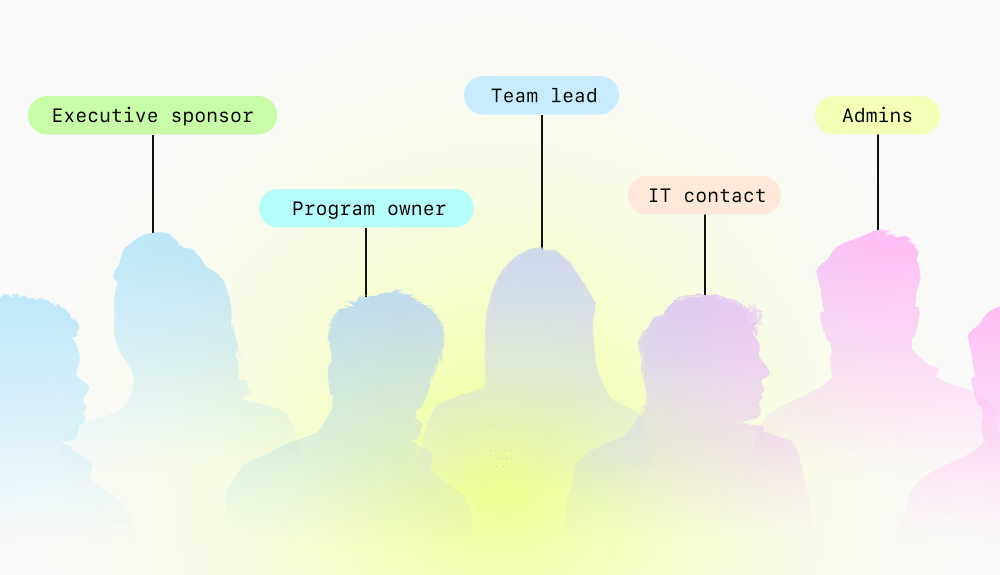Enterprise transformation
– 8 min read
The key roles to drive success in enterprise generative AI implementation

As generative AI emerged as an enterprise technology must-have, companies were buying software, turning it over to their end-users, and expecting output to simply … happen. No surprise, this wasn’t a successful approach. Enterprise systems of the past were filled with forms, fields, and data, whereas generative AI often starts with a blank screen. End-users had no idea how to approach generative AI technology.
We’ve seen so much evolve throughout 2023 as teams look to implement AI solutions effectively. People can now obtain certificates from AI “Centers of Excellence.” Entire teams and roles have emerged that didn’t exist six months ago.
Enterprise companies have realized that they need to take a more methodical approach to generative AI implementation if they want it to be successful. It’s not only about initial success, but also about building processes and internal resources that make generative AI more self-service and scalable in the future. For that to happen, companies need to involve the right people in implementing a generative AI solution.
- Enterprise companies have realized they need to take a more methodical approach to generative AI implementation.
- Without a team and plan in place, no one will know what next steps to take.
- There’s typically a hierarchy of roles starting at an executive level and trickling down to interactions with the end users.
- An AI program director can play a critical role in your success with AI.
Key roles in AI implementation
Because generative AI has impacts across the organization, there’s typically a hierarchy of roles starting at an executive level and trickling down to interactions with end users. Without a team and plan in place, no one will know what next steps to take.
Executive sponsor
Without a leader pushing for AI initiatives, they can fall flat. An executive sponsor is responsible for driving overall strategy, securing internal resources (personnel and funding), and making sure that people are aligned across the organization.
Executive sponsors focus on the goals of the business and ultimately want to prove the ROI of their AI strategy. This often manifests in time saved to free employees up for more creative work or projects they wouldn’t be able to start without the assistance of AI. To do this, they’ll collect feedback from the team during implementation and continue analyzing the results as the team matures through onboarding.
AI program director
In some cases, companies end up with a role dedicated to generative AI rollout and ongoing program management. These companies know that introducing AI within the organization isn’t a “one-and-done.” It takes an ongoing commitment to stay current, roll out additional use cases, and train new employees.
The AI program director is responsible for ongoing project management. They organize and prioritize rolling out AI use cases and communicate progress to the executive sponsor. They’ll also outline the next steps in the implementation while staying aligned with the executive sponsor’s overall strategy.
If the vendor for the chosen solution continues to provide support during implementation (as they should!) the AI program director will work closely with the vendor. They’ll also work with the team leads responsible for the rollout to end users.
An AI program director can play a critical role in your success with AI. Read more about how this role fits into your org and what the responsibilities should be.
Technical manager/IT admin
It’s a good idea to have an IT team or IT administrator involved early. They may be discussing risk and security concerns before a generative AI solution is even purchased.
Since IT is responsible for releasing technology across different departments, they’ll be involved in user accounts, provisioning, APIs, and other integrations. The line of communication should remain open, particularly with data governance and any ongoing auditing or monitoring.
Team leads
Team leads are responsible for rolling out strategy from the AI program director to the end users. They’re involved in the nitty gritty — the details of what use cases look like for their specific teams and developing best practices and effective prompts.
Team leads should aggregate feedback from end users, both their successes and their challenges. That information is then shared with the AI program director so they can continue to monitor the implementation’s progress. They’re connecting the dots between the AI strategy and what AI implementation looks like on a day-to-day basis.
Because AI implementation will likely be new to team leads also, a really effective tactic for collecting information is to have end users share their specific prompts. This can help create templates or give ideas to other members of the team — particularly those who may be struggling to come up with their own prompts.

Incorporating generative AI into daily work
Rollout should be a multi-pronged approach and it’s important for the implementation team to keep this in mind. End users will be more receptive if they see value in generative AI as fast as possible. But deeper levels of value take longer to unlock, because they require more planning and testing for complex workflows. Once those first two prongs are done, the implementation team will also want to think about maintaining the impact of generative AI long-term.
Roll out some quick wins
Generative AI in an enterprise setting will likely be new for end users — even if they’ve tinkered with AI on their own. The implementation team should shoot for some quick wins so people can understand how the chosen platform works.
WRITER has some out-of-the-box AI apps for common use cases like generating a blog post outline or recapping a webinar. These can be used to train people and help them get their feet wet.
Work toward more specific use cases
The real power of generative AI comes from moving beyond templates and simple use cases. Organizations will want to build out prompts that are specific to their workflows. That takes time to understand the specific needs and coordinate between the team leads and the AI program director.
WRITER connects our Palmyra LLMs to your business data, such as cloud storage platforms and data repositories. With this, companies can create highly specific use cases based on their own data. For example, Adore Me uses a custom app in WRITER to generate press releases. The press releases are based on an input of bullet points for the release’s key message.
Create internal documentation and training guides
End users will get the most attention during initial implementation, but companies need to think about new employees and how they’ll get up to speed with the generative AI strategy. This includes creating internal documentation, custom prompt libraries, and AI onboarding certifications to empower the team.
Internal resources may fall under a training or enablement team or be created within specific business units. Oversight would fall under the AI program director and should be baked into the overall implementation plan.
Collaboration and communication during rollout
Successful implementation is highly dependent on end users, since they’re the ones who’ll be relying on generative AI for their daily work. The executive sponsor, AI program director, and sometimes even team leads don’t know what day-to-day workflows look like for users.
People usually fall into one of two categories. On one side, they’re afraid of AI and are hesitant to use it. And on the other side, they think they can click a button and reduce their 8-hour workday into minutes.
Neither of these is true and the implementation team needs to bring people to a middle ground where they can see success. AI doesn’t replace humans and also requires specific prompting to be effective. First passes will get end users from a blank page to output that’s maybe 70% of the desired result, but then it’ll take the specific expertise and understanding of the business to polish it to something that’s fully ready and publishable. The back-and-forth and learning curve of prompt crafting are the hardest hurdles to overcome initially.
Throughout all of this, messaging is important. From the highest levels of the company, it should be emphasized that generative AI is a powerful assistant that people can use to do their jobs more effectively and efficiently. It’s not meant to replace jobs or sacrifice quality.
AI roles are often tied to career interests
Successful implementation is often dependent on the people involved: do they have a genuine interest in AI? At WRITER, we’ve seen the most successful implementations happen when the key roles are filled by people who want to align their careers with the AI movement. They see the future and know that using AI is a skill set they want to develop.
It’s been inspiring to see job descriptions appear with requirements around AI knowledge or experience. People interested in AI will really push for implementation success because they know it will grow their careers. If your chosen vendor is supporting you throughout implementation, these people will be a critical part of communicating the business’s specific needs.
These roles, and the people involved, are a crucial component. The difference between a solution that people rely on every day and a product that “sits on a shelf,” never used.
AI implementation will also include governance, such as creating clear internal guidelines and mitigating risks. Read more in our guide: Generative AI governance: A toolkit for enterprise leaders.
